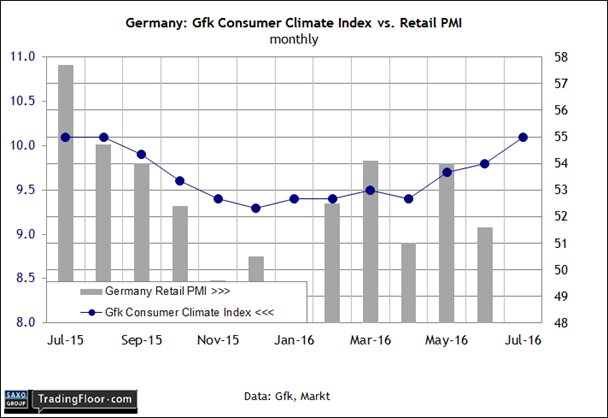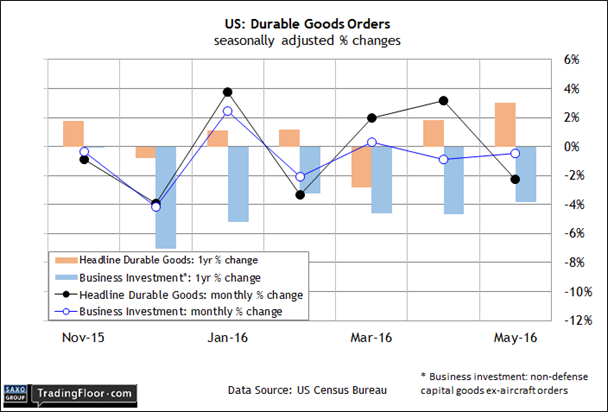- Gfk German Consumer Climate Index is set for a mild dip
- US durable goods orders on track to fall despite buoyant consumer spending
- No change forecast in the US rate decision, but the vote may not be unanimous
Wednesday brings another busy day of economic news, starting with the monthly update of Gfk’s Consumer Climate Index for Germany. Later, the June report for US durable goods orders arrives, followed by the Federal Reserve’s interest rate decision and Federal Open Market Committee policy statement.
Germany: Gfk Consumer Climate Index (0600 GMT): Will the recent string of terror attacks in Germany dent economic growth? No one knows the answer at this point, but the subject has become topical as the nation tries to make sense of a series of violent attacks.
The fear is that terror worries will reduce consumer and tourism-related spending. A significant drop in consumption is unlikely, but everyone will be watching the incoming economic reports a bit more closely for any signs of stress.
The real test will come in the weeks and months ahead. Meantime, today’s Gfk update on sentiment will provide a reading on the mood in recent weeks. Note that the Consumer Climate Index has been rising in recent months, reaching an 11-month high of 10.1 in last month’s release.
The outlook is a bit more subdued in relation to the Germany Retail PMI data for June. The index fell to 51.6 last month from 54.0 in May, indicating a sluggish pace of growth. Nonetheless, “the general trend in retail sales remains positive, with growth reported in each of the past five months,” an analyst at Markit Economics noted earlier this month.
Econoday.com’s consensus forecast calls for a mild dip in CCI to 9.9 in today’s report. But that still leaves the index at an elevated level compared with recent readings. The question is how next month’s update will look. The answer, unfortunately, may depend on events beyond the traditional macro realm.

US: Durable Goods Orders (1230 GMT): Demand for durable goods has been hinting at a recovery in recent months in year-on-year terms, but today’s update is expected to deliver another setback in the monthly comparison.
Econoday.com’s consensus forecast sees headline orders slumping 2.2% in June, which will mark the second monthly decline. Even worse, the projected decline will pull the year-on-year trend back into the red for the first time since March.
The forecast implies that business investment in equipment (orders less defence and aircraft) is on track to remain negative. The year-on-year trend in this corner, which is considered a proxy for corporate spending, has been negative since last November and relief is unlikely in today’s update.
The good news for the US economy is that consumer spending remains upbeat, which suggests that the weakness in capital expenditures in the corporate sector is only a minor threat to the big picture macro outlook. Retail spending in June posted a strong 0.6% gain, boosting the year-on-year increase to a firmer but still middling pace of 2.7%.
Nonetheless, some analysts point out that softer business investment tends to be linked with weaker job growth. But that looks like a distant concern after the surge in job growth last month. Yet with lingering concerns about economic growth, a disappointing report on durable goods orders will serve as a reminder that macro risks are still lurking, even if the immediate threat of a recession is a low-probability event.

US: Federal Reserve Federal Open Market Committee Statement and Interest Rate Decision (1800 GMT): The economic outlook is moderately brighter these days, but the Federal Reserve is still widely expected to leave interest rates unchanged at the current 0.25%–to-0.50% range.
Friday’s “advance” GDP report for the second quarter is on track to post a 2.4% increase (seasonally adjusted annual rate), based on the Atlanta Federal Reserve’s July 19 nowcast. Some analysts are looking for even better results. Indeed, several economists polled this month by The Wall Street Journal anticipate Q2 growth to exceed 3% – well above the survey’s average forecast of 2.5%.
As usual, the GDP estimates vary, but virtually everyone’s united in expecting a substantial improvement over Q1’s sluggish 1.1% rise. Nonetheless, the Fed will probably take a pass on squeezing policy today. The vote, however, may not be unanimous, as it was at last month’s meeting.
“It will be contentious,” predicted Jonathan Wright, a former Fed economist who’s now an economics professor at Johns Hopkins University. “There are big differences of opinion.”
Meantime, Treasury yields have been rising again, based on recent changes in the 2- and 10-year yields. But while both rates have bounced from the sharp dip in yields that grabbed everyone’s attention in early July, the rebound looks a bit subdued – particularly for the benchmark 10-year Treasury yield.
That may change once we move closer to the Fed’s September meeting, a possibility that will inspire a close reading of today’s FOMC statement for clues. “Expectations are growing that the FOMC will signal a possible September hike at this week’s meeting,” advised the head of portfolio strategy at Evercore ISI via the FT.
Perhaps, but at the moment, the central bank is set to reserve judgement.

Disclosure: Originally published at Saxo Bank TradingFloor.com
